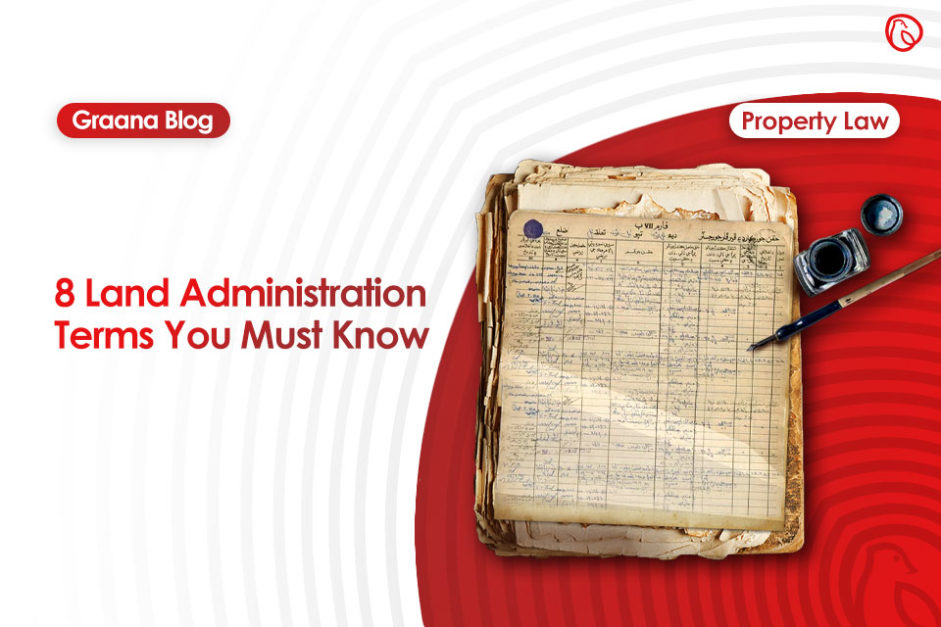To better understand real estate buying and selling processes, one needs to be familiar with basic land administration and revenue related terms. Such processes generally involve lawyers and revenue officials who take care of the complex glossary; we cannot, however, ignore its significance for a realtor, investor and customer of the modern real estate industry.
The following list explains some basic and important terms related to land administration and revenue systems of Pakistan. It does not follow any predetermined order; hence must be understood in isolation or in conjunction with other concepts wherever necessary.
| Jamabandi Form |
| Fard |
| Theka |
| Inteqaal |
| Haq-e-Shufa |
| Kilabandi |
| Bandobast |
| Sale Deed |
1. Jamabandi Form
This document contains revenue record that shows information about the ownership and possession of any property, type of the land, source of irrigation (if agricultural), the type and nature of construction on the property, its existent holding status, the nature and status of the owner, location of the land, and its division, etc.
A common perception prevails that the Jamabandi form is very hard to interpret, owing to its legal jargon. We have tried to explain major columns of the form for the understanding of a general reader:

i. Khewat number
It indicates a unique account number given to a set of owners who own a portion of land with multiple Khasra numbers; for example, a family whose various members collectively possess a portion of land.
ii. Khatauni number
It indicates a unique account number given to a set of cultivators who cultivate a portion of land with multiple Khasra numbers. Any change that takes place in the possession of the land is endorsed in the Khatauni via mutation proceedings. The Khatauni generally contains information about the tenure-holder, his/her guardian’s name, address, duration of occupancy, amount of revenue or rent, etc.
iii. Khasra number
It is a unique plot number or survey number given to any specific piece of land. A single Khasra number can have 8 Kanals 0r marlas (means one acre) at maximum. However, if the land is barren or hilly, the area for a single Khasra number can exceed one acre. The column also includes the type of land. If it holds any building, the column mentions “ghair mumkin”. The type of land is “Chai” if it is irrigated by wells; “Nehri” or “aabi” if by canals, while “Barani” if the source of water supply is rainfall only.
iv. Details of Owner
It requires the names of the owner, his/her father and grandfather to warrant and ensure the exact identity of the individual, as any other person in the adjoining regions can carry the same name.
v. Details of Possessioner or Cultivator
If owner and possessioner or the cultivator of the land is same, the term “Khudkasht” (Kasht means cultivation) is mentioned in the column. If different, the term “Ghair Marusi” is cited.
vi. Details of Lagan
In case a piece of land is cultivated by someone other than the owner, he/she is liable to pay the owner the value of mutually agreed share of the produce. The agreement between the parties is known as ‘Lagan’. Therefore, if any sales deed exists in any land, the amount/value of the revenue will be mentioned in this column.
vii. Remarks Column
Every entry related to sale purchase or any other transaction in the current Jamabandi will be endorsed in this column. On next Jamabandi, the entries are taken to Khewat or Khatauni column. Every entry carries a specific reference or intkaal number. It must be noted that any wrong entry in this column might change the ownership status of the property.
Since Jamabandi is an important document, it must be ensured that all relevant entries are properly endorsed. Generally, when a property is purchased and its registry is made in the registrar office, its entry is recorded in the Intkaal register, and further in the daily diary (roznamcha) of a Patwari who brings the transaction (the entry) into the Jamabandi form. In case the transaction is not reflected in the Jamabandi form, a consistent threat of double sale, double mortgage, double charge and other deceitful activities looms around the property.
2. Fard
It is a document that shows ownership of a piece of land. The details are based on the record of a Patwari, which is, in fact, a record of the revenue an owner pays for the said land. Since Fard is used for a variety of purposes, it can take multiple forms. Major types are given below:

i. Record Purpose
This type of Fard is obtained by an individual for his/her personal record to confirm and update his status of ownership of any piece of land.
ii. Fard e Bey
This type of Fard is obtained by an individual when they intend to sell their property through registry. It is issued only to the owner or a person duly authorized by the owner. If registry is not carried out within 15 days of obtaining the Fard, the new Fard can only be issued if the previous one is being canceled.
iii. Fard for Bail
This Fard is collected to be presented in the court for obtaining bail.
iv. Fard for Gift
If owner of the property intends to gift their property to anyone through registry, they obtain this Fard.
v. Fard for Mortgage
The Fard is applicable when owner of any property mortgages their property to any individual or organisation.
3. Theka (Lease)
It is a contractual agreement that allows the tenant to use a property owned by the landlord in exchange for rent (monthly, annually or as the case maybe). In case of agricultural lease, the tenant can use the leased land for the purpose of production, growing, harvesting and farming of produce.
4. Intkaal (Mutation)
It is a process in which the title of ownership of a property is transferred to another person; in other words, it is a document that shows transfer of a registered land. With the process, the new owner of the property is liable to be charged with a property tax. It is advised that mutation of any property should be collected from the local land administrator.

5. Haq e Shufa (Pre-emption Right)
It is a preferential right ‘to become the buyer of immovable property’. The spirit of the right under Muslim law is to prevent a stranger from purchasing land that could be more beneficial to the neighbor. The neighbor thus has to be the first potential buyer of an adjacent piece of property.
6. Kilabandi
It is the procedure of substituting irregular fields for rectangular fields of the uniform size. The technique was originally intended to be used for waste areas only; however, owing to its usefulness, it was soon extended to fertile and cultivated lands as well. The division of the land into rectangular plots (Kilabandi) makes the water distribution easier and cost-effective.

7. Bandobast
It is a Persian word which means ‘settlement’. It involves all the operations related to the specification and assessment of land revenue. It has to be a meticulous procedure that involves collecting data from various offices and appointing an appropriate share of the state in any produce.
8. Sale Deed
It is a document that conveys the title of property from the seller to the buyer. It must identify the property, its price, payment details and the belonging of the land – whether it belongs to any society, builder, individual etc.

Our existing real estate system is based on a traditional land administration and revenue system. Although concerted efforts are underway to exclude various processes and individuals from real estate transaction activity – through digitization and automation – the previous and basic concepts are linchpins to modern knowledge economy.





Thanks for sharing your ideas about real estate. it’s a very informative blog.
It is possible that a plot have many khasra no
quite helpfull